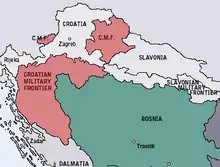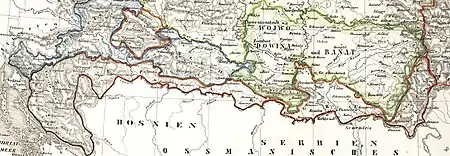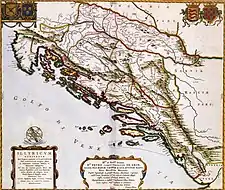Croatian Military Frontier
The Croatian Military Frontier (Croatian: Hrvatska vojna krajina or Hrvatska vojna granica) was a district of the Military Frontier, a territory in the Habsburg monarchy, first during the period of the Austrian Empire and then during Austria-Hungary.
| Croatian Military Frontier Kroatische Militärgrenze Hrvatska vojna granica Hrvatska vojna krajina Horvát határőrvidék | |||||||||||
|---|---|---|---|---|---|---|---|---|---|---|---|
| District of the Military Frontier, Habsburg monarchy | |||||||||||
| 1553–1881 | |||||||||||
 Croatian Military Frontier in 1868 | |||||||||||
| Area | |||||||||||
• 1870 | 14,903 km2 (5,754 sq mi) | ||||||||||
| Population | |||||||||||
• 1870 | 611,575 | ||||||||||
| History | |||||||||||
| History | |||||||||||
• Established | 1553 | ||||||||||
• Disestablished | 15 July 1881 | ||||||||||
| |||||||||||
| Today part of | Croatia | ||||||||||

History
Founded in the late 16th century out of lands of the Habsburg Kingdom of Croatia, it was initially a nominal part of that Kingdom, to be transferred in 1627 to direct imperial rule as part of the Military Frontier. The Frontier was located on the border with the Ottoman Empire. In the Frontier zone, the king-emperors promised free land and freedom of religion to people who came to the area with the majority of the population being Croats, Serbs and Vlachs.[1][2][3][4][5] In exchange, the people who lived in the area had an obligation to militarily fight for the Empire, and to protect the land. In 1630 Emperor Ferdinand II enacted the Statuta Valachorum laws.[6] It was known that the soldiers had to fulfill military service from the age of 16 until 66. In the end of the 17th century, Habsburg Kingdom of Croatia expanded its borders so territory of Croatian Military Frontier was also expanded to include some former Ottoman territories in the east. In 1783 it was placed under the unified control of the Croatian General Command headquartered in Zagreb.[7] The Military Frontier was demilitarized on 8 August 1873. Croatian Military Frontier existed until 15 July 1881, when it was abolished and incorporated into the Kingdom of Croatia-Slavonia (like the Slavonian one).
| History of Croatia |
|---|
 |
| Timeline |
|
|
Geography
This part of the Military Frontier included the geographic regions of Lika, Kordun, Banovina and bordered the Adriatic Sea to the west, Venetian Republic to the south, Habsburg Kingdom of Croatia to the north-west, the Ottoman Empire to the south-east, Habsburg Kingdom of Slavonia to the east, and Habsburg Kingdom of Hungary to the north.
It extended onto the Slavonian Military Frontier near the confluence of the Una river into the Sava. Like the rest of the Military Frontier, it ceased to exist as a political entity in the late 19th century.
Sections
Croatian Military Frontier included three General Command (Croatian: Generalat) sections which were divided into eight Regiments:
Demographics
In 1802, the estimated population consisted of:[8]
- 195,300 Roman Catholics
- 180,800 Orthodox Christians
In 1820, estimated population of Croatian Military Frontier included:[9]
- 207,747 Catholics
- 198,728 Orthodox Christians
According to Hungarian statistician Elek Fényes, in 1840 the Croatian Military Frontier was populated by 498,947 people and the ethnic structure was:[10]
The first modern census from 1857 recorded the religion of the populace of Croatian Military Frontier:[11]
- 285,344 Roman Catholics
- 253,429 Orthodox Christians
- 5,433 Eastern Catholics
74.8% of the active population in Croatian-Slavonian Military Frontier were employed in agriculture, 18.63% were inactive soldiers, while 3.11% were working in industry.[12]
See also
References
- Traian Stoianovich; (1992), Balkan Worlds: The First and Last Europe: The First and Last Europe p. 152; Routledge, ISBN 1563240335
- Noel Malcolm; (1996), Bosnia: A Short History p. 98; NYU Press, ISBN 0814755615
- Ferenc VÉGH; (2017), University of Pécs Institute of History, The Contribution of the Hungarian Historiography to the Research on the "Military Frontier" in the Early Modern Period (16th-17th Centuries), {The Habsburg government in this way came to relatively cheap military force using the South Slavic (Croatian, Vlach, Serbian) grencers} #page= 169
- Ivo Banac; (1984) The National Question in Yugoslavia: Origins, History, Politics p. 43; Cornell University Press, ISBN 0801416752
- Karl Kaser; (2012) Household and Family in the Balkans: Two Decades of Historical Family Research at University of Graz p. 123-124; LIT Verlag, ISBN 3643504063
- Statuta Walachorum
- Gunther Erich Rothenberg: The Military Border in Croatia, 1740-1881: a study of an imperial institution, University of Chicago Press, 1966, p. 63
- Mladen Lorković, Narod i zemlja Hrvata, page 86
- Dr Tomislav Bogavac, Nestajanje Srba, Niš, 1994, page 196.
- Elek Fényes, Magyarország statistikája, Trattner-Károlyi, Pest 1842, page 50
- Statistische übersichten über die bevölkerung und den viehstand von Österreich nach der zählung vom 31. october 1857, page 172
- Mariann Nagy - Croatia in the Economic Structure of the Habsburg Empire in the Light of the 1857 Census, p. 88
Further reading
- Rothenberg, Gunther E. (June 1960). "The Origins of the Austrian Military Frontier in Croatia and the Alleged Treaty of 22 December 1522". The Slavonic and East European Review. Maney Publishing. 38 (91): 493–498.
- Rothenberg, Gunther E. (March 1964). "The Struggle over the Dissolution of the Croatian Military Border, 1850–1871". Slavic Review. American Association for the Advancement of Slavic Studies. 23 (1): 63–78. doi:10.2307/2492376. JSTOR 2492376. S2CID 159876996.
- Fodor, Pál; Dávid, Géza, eds. (2000). Ottomans, Hungarians, and Habsburgs in Central Europe: The Military Confines in the Era of Ottoman Conquest. BRILL. ISBN 9004119078.